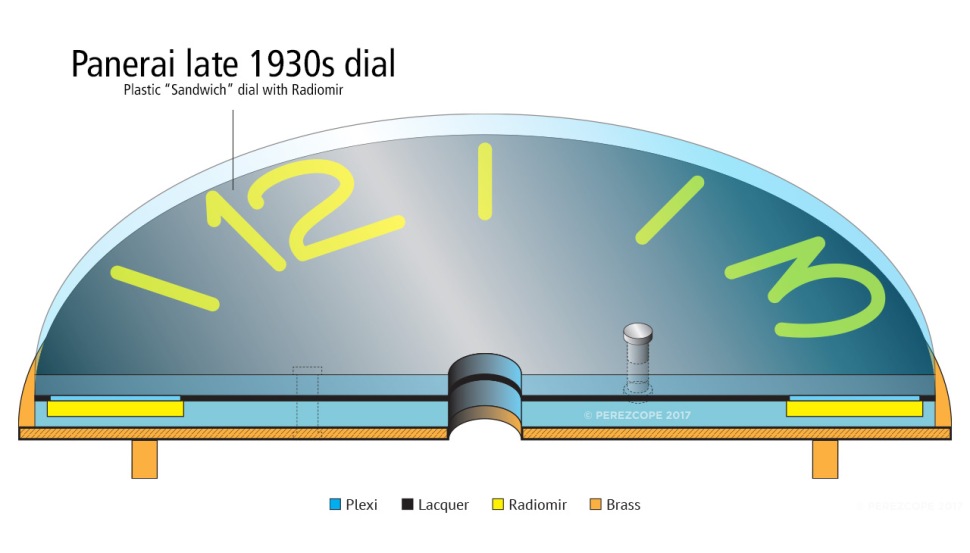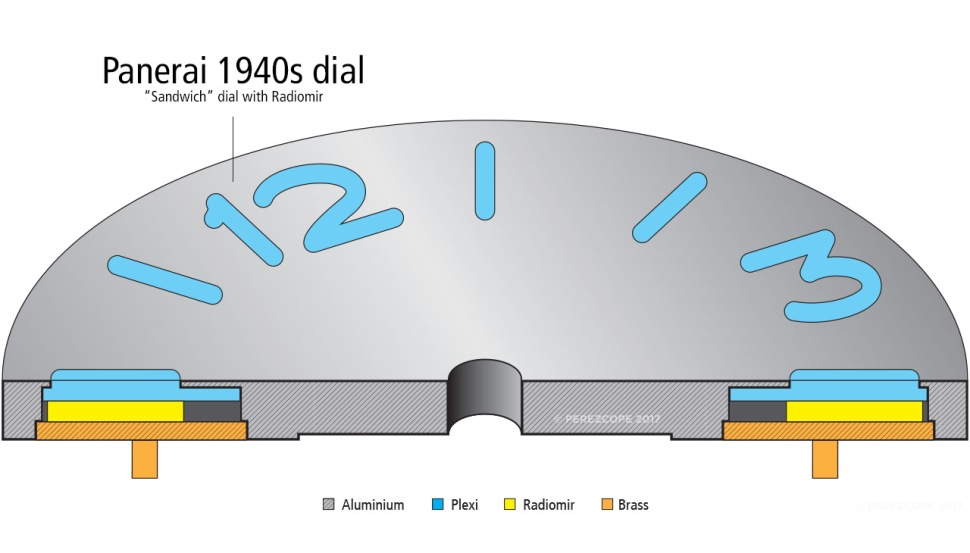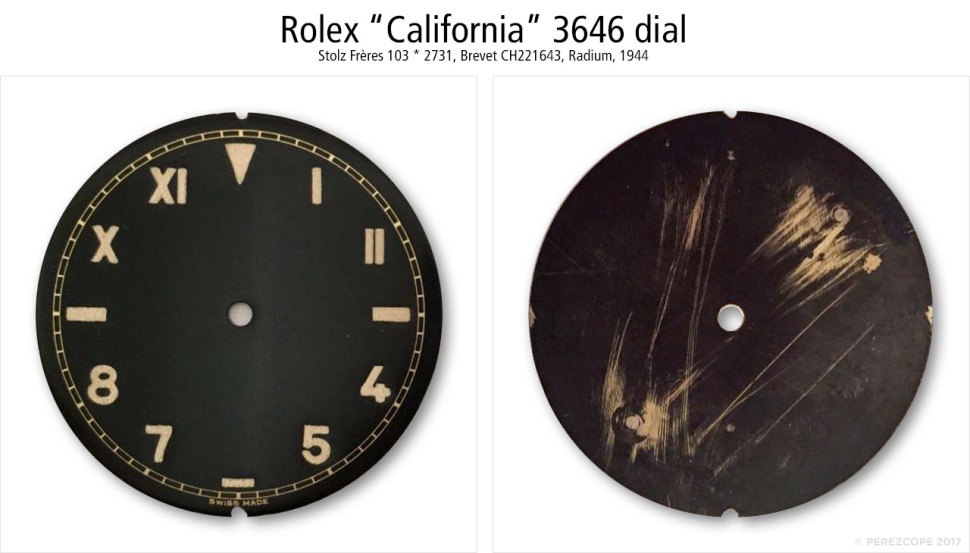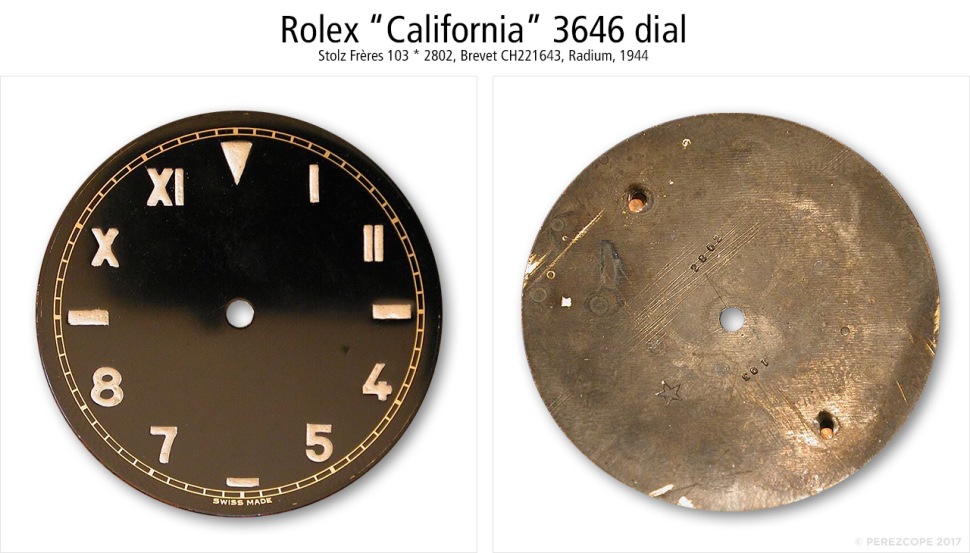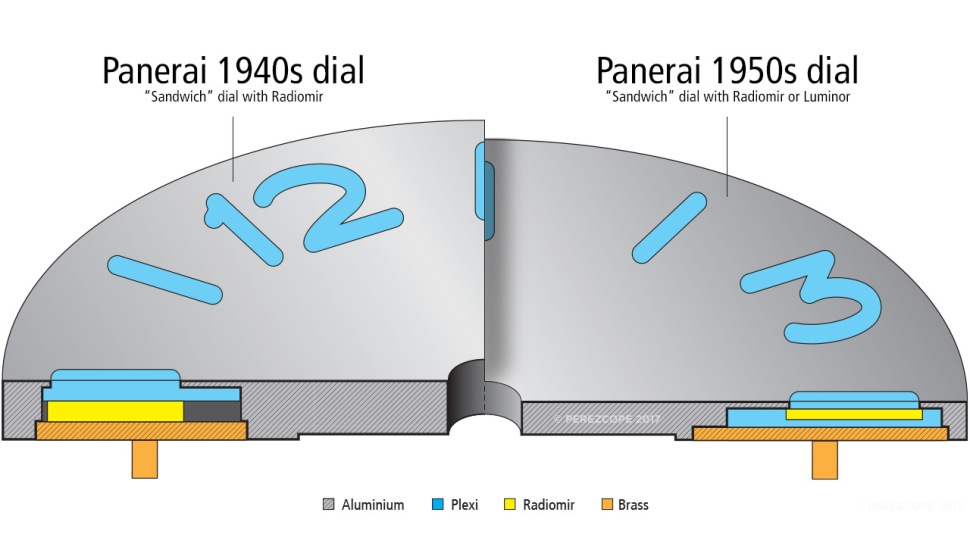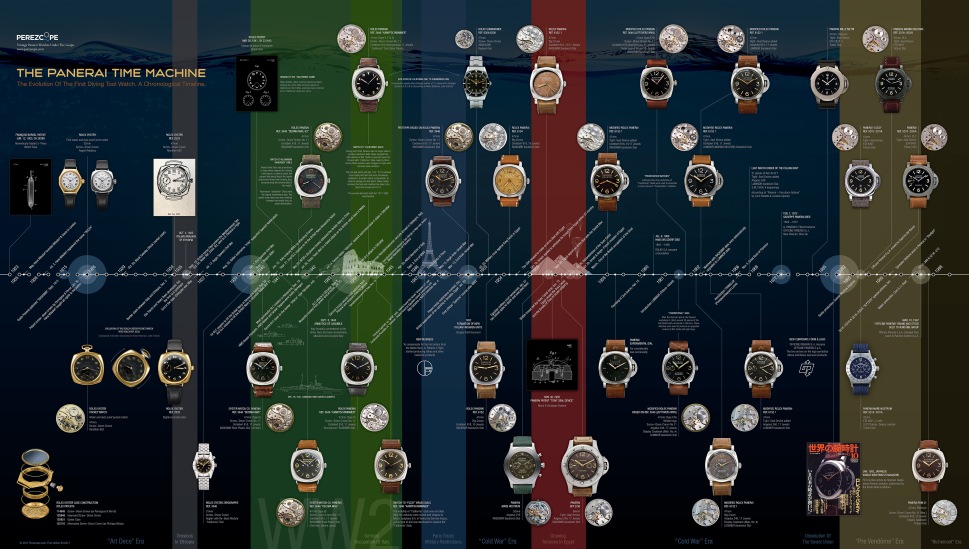The value of a historic watch depends to a very large extent on the condition of its dial, the “face” of a watch, and also whether the dial is original to the watch or not. Historic Panerai watches are certainly no exception.
A watch face can be so charismatic and dominant that it almost overshadows the rest of the watch. In the case of Panerai and probably for the first time in the history of watchmaking, a dial maker (Panerai) is being portrayed as a watch manufacturer. The need for these watches may have originally come from Italy but it was Rolex, in its relentless pursuit to create the perfect wristwatch, who was the real driving force behind the first professional diving watches worn by the daring assault swimmers of the Decima MAS.
Rolex designed and produced a series of different watch references on specific request of G. Panerai e Figlio in Florence. The Florentine company received exclusive rights for a duration of 15 years, the intellectual property for the designs (Registered Design), however, remained with Rolex.
Panerai developed 2 watch models on its own, the GPF 2/56 and the Mille Metri, of which only around 60 watches were made until 1997. The majority of the watches that are seen as historic Panerai watches were designed and produced by Rolex.
Panerai was responsible for the highly sophisticated dials with an outstanding legibility in the main application area of the Decima MAS assault swimmers, dirty and murky waters of enemy harbours. The luminosity was so high that divers had to cover the watch with cloths to avoid being spotted by sentinels on the surface.
This extraordinary luminosity was achieved with a radium-based substance named RADIOMIR. Contrary to populare belief, RADIOMIR was never patented. Self-luminous radium mixtures were known since 1903. The Panerai patent from 1915 referred to radium gun sights which made it possible to aim at targets in the dark. Radium-226 is highly radioactive with a half-life of 1,600 years.
G. Panerai e Figlio developed a series of different dials always using intricate multi layer “sandwich” constructions with the goal to insert as much RADIOMIR paste as possible. These ingenious dials evolved over time and around 1942 the initial setup was radically changed.
The following list is an attempt to place every dial in the correct chronological order and historical context.
.
Ref. 2533 (1936 – 1939)
Ref. 2533 is a mysterious reference. 3 separate Rolex invoices from June 1936, November 1937 and March 1939, which were supposedly found in Giuseppe Panerai’s office in 2010, give only limited information about the dials used in these watches. The last invoice from March 1939 states “cadrans fournis par la Maison PANERAJ” (dials provided by the house Paneraj).
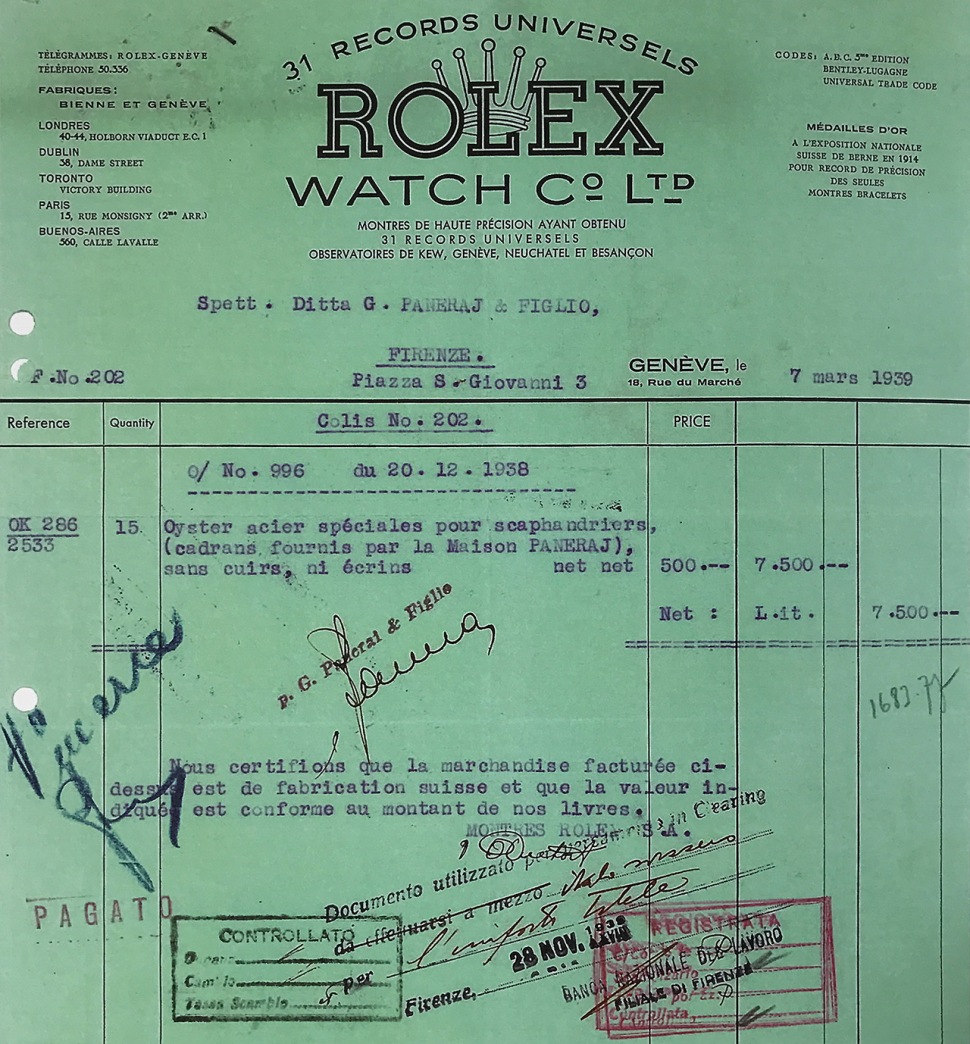
.
There are 2 known watches of Ref. 2533. The first watch is the famous case number 116272 with the legendary “Baton” prototype dial.
In 2012, Officine Panerai paid tribute to this iconic piece and released a replica of it, the Special Edition PAM 449.

.
The second watch is case number 116275, a watch that was apparently owned by Mario Giorgini, a Decima MAS mission commander who was taken prisoner on September 30, 1940 near Alexandria and spent the entire war in a prison in India. This watch features a first generation aluminium “sandwich” dial with characteristic dark red patina. This type of dial is very common for Ref. 3646 Type C from 1942.

.
Apparently there is a third 2533 featuring a plastic rivet dial.
The watch pictured below is a 3646 from the Archivio Storico Panerai (Panerai Museum). According to Officine Panerai’s website, this watch is a prototype from 1936.
A closer look, however, reveals that this watch is actually one of the last 3646 delivered by Rolex in 1944. The way the crown tube is soldered to the case, the “short” wire lugs and ultimately also the “anonymous” Cortebert Cal. 618 that is fitted to this watch leave absolutely no doubt. By the way, the “California” dial does not look like a regular dial.

.
Claims by Officine Panerai that the first prototypes were delivered with “California” dials are not accurate in my opinion.
Rolex developed the “California” dial around 1941. I believe the only reason why some early 3646 watches feature “California” dials is due to the fact that the original dials (probably plastic rivet dials) became useless and “California” dials were still available and a cheap replacement. Evidence for this can be found in the simple fact that most of these watches are equipped with a high bezel and a tall cannon pinion, both meant for thick “sandwich” dials.
.
Ref. 3646 (1940 – 1944)
Ref. 3646 was the first exclusively for G. Panerai e Figlio produced watch. Rolex delivered the first examples in April 1940. These watches were probably delivered with a simple interim dial which was later replaced by G. Panerai e Figlio with first generation plastic rivet dials (pin dials).
The earliest 3646 registered until now is case number 1009421, a watch that is in exhibition in the Museo Tecnico Navale in La Spezia, Italy.
German experts consider this watch to be in “unaltered original condition” but this assessment is not accurate. The dial of 1009421 in the picture below is a typical 1950s dial.

.
The owner of this watch was Ernesto Notari, a former Decima MAS member and SLC pilot (Siluro a lenta corsa, manned torpedo). The inventory documents of the Museo Tecnico Navale state that the watch has been serviced by Panerai. It is more than likely that the original dial, probably a plastic rivet dial, had to be replaced during the service.
However, 1950s/1960s dials are easy to spot once the differences in construction have been understood.
.
Plastic Rivet Dial aka Pin Dial (late 1930s)
Considering the number of early 3646 with plastic rivet dials it can be assumed that this type of dial was the first to be installed, even in Ref. 2533 of the late 1930s.

.
Early watch dials made by G. Panerai e Figlio consist of 3 layers. 2 plastic discs and 1 thin brass disc forming the backplate of the dial. The whole construction was held together by two metal rivets.
The top layer was a plastic disc with black lacqueur on the back. The arab numerals, the hour indices and the “RADIOMIR PANERAI” inscription were carved out the black lacquer.
Underneath the top layer there was a second plastic disc with cavities at the 4 cardinal points and hour indices. This is where RADIOMIR paste was filled. The RADIOMIR would shine through the carved out numerals and indices of the top layer. The transparent plastic disc was probably also meant to amplify the luminosity.
This intricate construction proved to be very fragile. When exposed to a strong heat source the plastic began to warp and in severe cases the dial would touch the hands and prevent them from turning, thus compromising the functionality of the watch.

.
Perhaps the warping was also caused by the high amount of radioactive emissions.
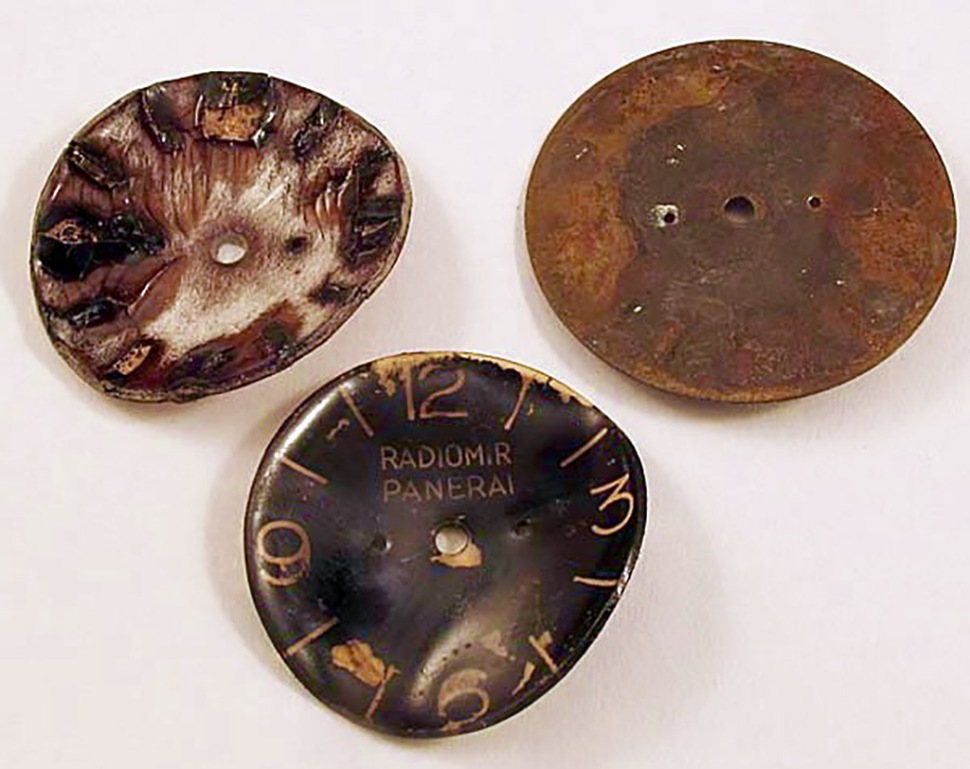
.
Several dial manufacturers tried to build a stable construction. While the first dials appear to have been made by Panerai itself, surprisingly, the following batches were produced by renowned Swiss dial manufacturers like Stern Frères (Geneva), Zelime Jacot (St. Imier) and Metalem (Le Locle).
.
The following dial was made by Zelime Jacot (Cadrans Flückiger SA), a Swiss dial manufacturer from St. Imier. The Radiomir Panerai inscription has a wider font than the one above. This font is very similar to the one used in later aluminium “sandwich” dials.
This type of dial can be found mostly on 3646 Type C from 1942 and is probably the last series of plastic rivet dials.
.
1st Generation Aluminium “Sandwich” Dial (1941/42)
Plastic rivet dials had been a failure and needed to be replaced. Panerai e Figlio introduced in 1941/42 a completely new dial, again consisting of three different layers.

.
A large amount of lumimous Radiomir paste was encapsulated underneath a transparent layer of plastic which in turn was retained between two layers of metal, avoiding so any deformation. The upper disk was made of anodized aluminium and had perforated numerals and markers where the luminous material would shine through. Due to this construction, the numerals at 6 and 9 received their charismatic look with the open loops.
The “sandwich” dial idea was not new though. Longines had already introduced a very similar “sandwich” dial in their world renowned Chronograph 13ZN in 1936. The interesting thing about these Longines dials is the fact that they were produced by the famous dial manufacturer Stern Frères in Geneva, who patented this type of dial in January 1935 (CH182122).

.
The images below show a disassembled Longines 13ZN dial, consisting of 2 discs.

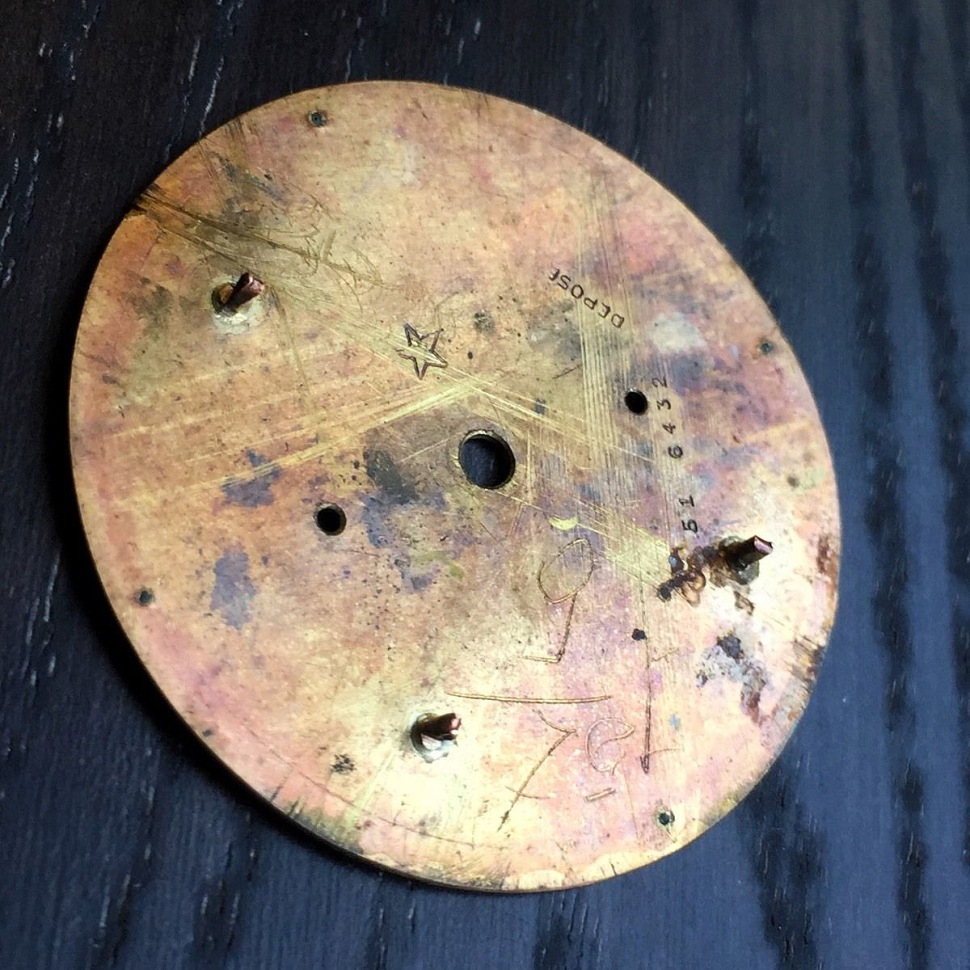
.
However, Panerai “sandwich” dials were a whole new level of sophistication. Considering their intricate construction, it can be assumed that their production was very time consuming.
First generation “sandwich” dials developed a very distinctive patina over the years. The RADIOMIR of the numerals and markers turned to a dark red colour.
.
The “RADIOMIR PANERAI” inscription was engraved respectively pantographed onto the aluminium disc and later filled with wax.
.
2nd Generation Aluminium “Sandwich” Dial (1943)
This type of dials were mainly installed in Nazi “Kampfschwimmer” 3646 Type D watches. The construction of the dial is basically the same as the previous generation but these dials have no “RADIOMIR PANERAI” inscription.

.
The patina of these dials is different compared to the previous generation. This could be an indication that the luminous paste had a different consistence.
.
The dials of this period differ also in other details from previous dials. It appears that they were produced in 2 batches. While the numerals at 6 and 9 of the first batch are identical to first generation dials, on the second batch both numerals are slightly different. The loops on the second batch are more open (b). The second batch is more common in 3646 Type D watches.
.
On January 4, 1944, around 30 Nazi Kampfschwimmer began their training in Valdagno, Italy, at the training site of the Decima MAS. Italy had been occupied in July 1943, after Benito Mussolini was toppled from power.
These dials were most certainly made during the Nazi occupation of Italy that took place between July 1943 and April 1945. A plausible explanation for the slightly changed design could be a rushed production of hundreds of dials. To avoid tearing off the “fragile” inner part of the loops, the spirals were left more open.
“Kampfschwimmer” dials have been subject to manipulation in the past 2 decades. Several of these are floating around bearing “fake” RADIOMIR, LUMINOR or MARINA MILITARE engravings.

.
“California” Dial (1944)
The charismatic “California” dial with its unique mix of roman and arab numerals was designed by Rolex and registered under “Brevet CH221643” as “Cadran de piece d’horlogerie” (Watch dial) in May 1941.

.
Rolex used to advertise it as “Error-proof radium dial”, due to its outstanding legibility. Numerals and markers were slightly recessed in order to take a higher amount of radium paste.
This type of dial was nicknamed “California” during the 1980s, after Rolex Bubble-Back watches featuring “Error-proof” dials became very popular and sought-after in California.
The document below is the original patent issued to Rolex on June 15, 1942 by the Swiss Federal Institute of Intellectual Property.
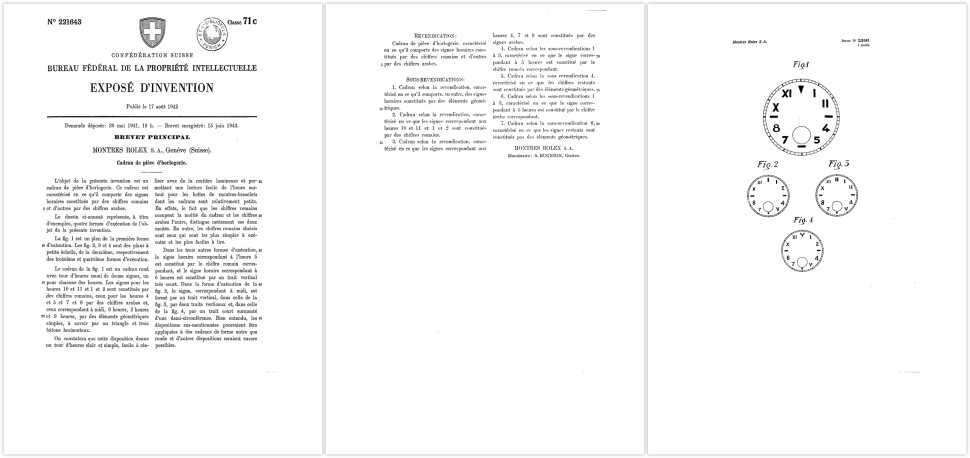
.
“California” dials found their way to “Panerai” watches in 1944. During the Nazi occupation of Italy, Panerai was no longer able to produce sandwich dials.
When in 1944 a new 3646 order was placed with Rolex, the request this time also included a proper dial with luminous material. Since there was no need for the extra space required by thick sandwich dials, Rolex redesigned Ref. 3646 slightly. As a result, the watch became considerably slimmer, due to a lower bezel and later also a thinner middle case.
Most watches of this era are completely anonymous. Dial, Case and movement do not have any Rolex markings, thus making it difficult to trace the watches back to their maker. Rolex was deeply rooted in the UK and for Hans Wilsdorf (Founder of Rolex) delivering these watches to the Nazis must have felt like treason.
What was Rolex’s motivation behind this deal? Was is to increase the revenue in difficult times? Was it to protect the Panerai family from the Nazi tyranny?
However, “California” dials for “Panerai” watches were produced by the renowned Swiss dial manufacturer Stern Frères S.A. in Geneva in 2 different batches.
.
1st “Flawed” Batch “California” Dial, Ref. 103 * 2731 (Stern Frères, 1944)
The first batch of “California” dials had reference number 103 * 2731 (103 = Rolex). This first batch left Stern Frères with a major flaw, probably due to an error in communication.
Rolex ordered a number of “California” dials for Cortebert Cal. 618 without pointing out that the dials were meant for wrist watches.
Having in mind that the Cortebert Cal. 618 was pocket watch movement, Stern Frères produced the dial with the typical pocket watch configuation with the crown at 12. Cal. 618 movements in Ref. 3646, however, were installed to have the crown at 3. This important detail was obviously missed. As a result, the watches would have had the 12 hour marker at 3.

.
In consequence and probably to salvage the dials, the dial feet were removed and 2 slots were cut out at 6 and 12 to fix the dial with tiny screws to the movement ring. This was without doubt a quick and dirty solution!
Was it done by Rolex after realising the mistake, or was it done by Panerai after receiving flawed watches? I find it hard to imagine that Rolex would have sent the watches with a wrong dial turned 90 degrees clockwise.
.
Affected by this error are probably mainly the last watches of Ref. 3646 Type D with case numbers 260695 to 260838. The “California” dials of most of these watches were later replaced with brass dials.
.
2nd Batch “California” Dial, Ref. 103 * 2802 (Stern Frères, 1944)
Stern Frères produced a new batch of “California” dials with Ref. 103 * 2802 and this time the dials were flawless.

.
Starting with case number 260850, all watches have the rectified dial with the correct dial feet position.
.
With this information at hand, it will be easy to understand whether “California” dials were used before 1944 or not. If an early 3646 has a “California” dial with ref. 103 * 2802, it can be assumed that the orginal dial was replaced.
On a different note, according to Jake Ehrlich, author of Jake’s Rolex World, the “California” dial evolved over the years to what would later become the Submariner dial, one of the most iconic dials ever made. A comparison between the 2 dials shows indeed striking similarities.

.
To understand the next type of dials it is necessary to go back to the faulty 1st batch of “California” dials with Ref. 103 * 2731. Several of these dials are floating around. All of them were found in the early 1990s, among other Panerai stuff, on the island of La Giudecca in Venice at the premises of the old watch company Arturo Junghans S.A. and this is why:
After several Nazi defensive lines south of Rome had collapsed by the end of May 1944, it was only a matter of time before the Allies reached Florence.
Aware of this imminent threat, the Nazis paid Panerai a visit and seized all machinery and material from the workshop. On August 2, 1944, Nazi parachut troopers blew up all bridges over the Arno in Florence, except for the Ponte Vecchio, to slow down the advancing British 8th Army. The Nazis retreated behind the heavily fortified Gothic defensive line further north.
Everything that was stolen from the Panerai workshop was shipped to Arturo Junghans S.A. on the island of La Giudecca (1) in Venice, very close to the island of San Giorgio in Alga (2), where the Nazi Kampfschwimmer had a secret training facility.
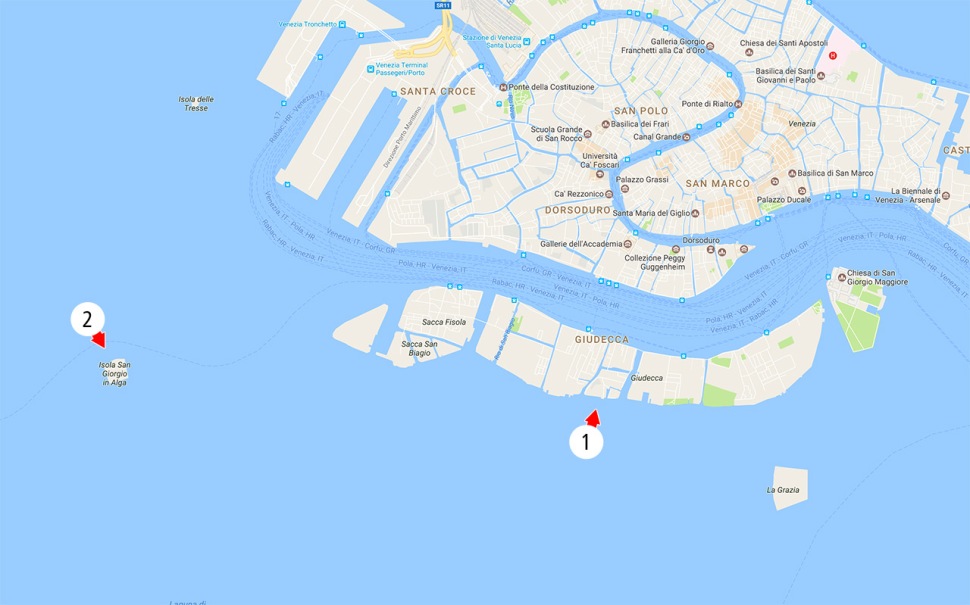
.
After the Battle of Rimini in September 1944, the Allies had come dangerously close to Venice. The Nazi Kampfschwimmer left Venice on November 18, 1944 and resumed their training on Sylt, an Island in northern Germany.
However, coincidentally there are also a few 3646 with later brass dials that are attached to the movement ring with screws. These dials have no dial feet and similar slots at 6 and 12 like flawed “California” (103 * 2731) dials.
The picture below shows parts of case number 260818. This watch was most certainly delivered with one of those flawed “California” dials. When the dial was replaced in 1944, the new dial was installed in the same way as the watch had been received.
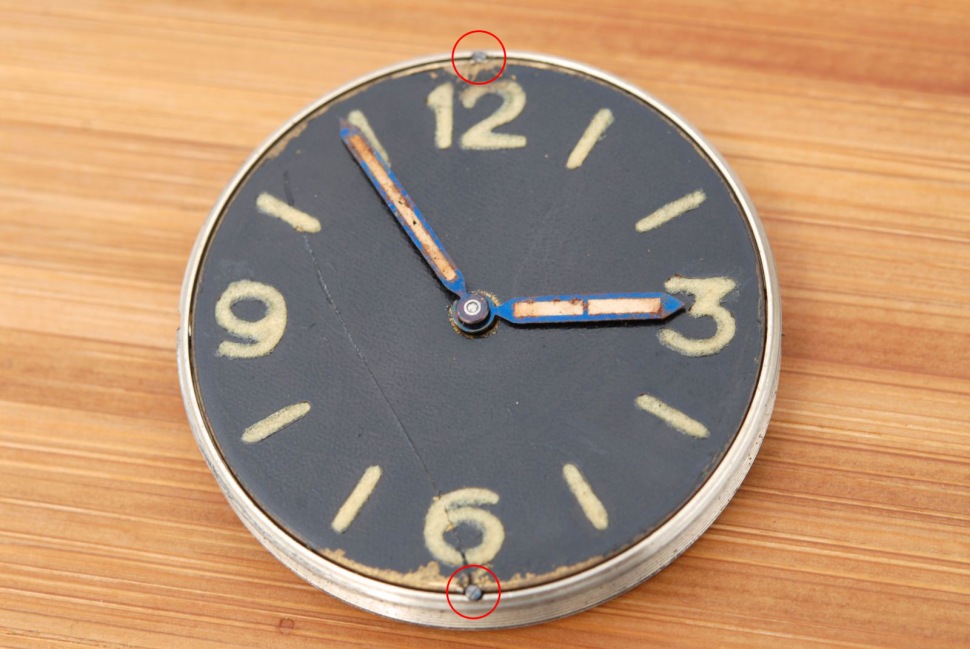
.
Brass Dial (1944)
It appears that the luminosity provided by the “California” dials was insufficient. A completely new dial was therefore developed. Although the visual design was based on typical Panerai dials, the construction, however, was more than basic.

.
Brass dials consist of a 1 mm thick brass disk with recessed arab numerals and markers. After the surface was painted with a black colour, the numerals and markers were filled with a luminous paste. Most dials have a fuzzy look due to a very inaccurate application of the lume.
.
The maker of these dials is unknown but a vast number of finished and unfinished dials was found at the old premises of Arturo Junghans S.A. on the island of La Giudecca in Venice.
Watches with the faulty dial modification were fitted with brass dials without dial feet, using only the 2 tiny screw to fix the dial. Brass dials of later watches have dial feet.
.
Post-war period (1950s/1960s)
After the restrictions, imposed by the Paris treaty of 1947, had been completely abolished by the end of 1951, the Italian Navy began “officially” to rebuild their underwater assault units. As a result, G. Panerai e Figlio was once again asked to provide new underwater instruments and watches. The 3646 case construction was completely outdated by that time and Panerai, still without any experience in watchmaking, once again approached Rolex, the maker of the previous watches.
.
Ref. 6152 (1953)
3rd Generation Sandwich Dial
The first new reference of the post war period was Ref. 6152. G. Panerai e Figlio developed a new generation of sandwich dials for these watches. The past production of WW2 sandwich dials had proven to be very intricate and timeconsuming, especially the complicated application of the RADIOMIR luminous paste into single cells.

.
In consequence, the inner construction of the new sandwich dial was simplified and as a result the dials also became considerably slimmer.
The lume was no longer contained in special cells underneath the plastic layer. In modern dials, the lume was instead filled into recessed areas on the newly developed plastic layer. The luminous paste is located directly underneath the aluminium disc, unlike on 1940s dials, where the lume is noticeably further away. The perforated numerals and markers were later sealed with resin to secure the radioactive material in place.

.
The dials of this era have noticeably bolder numerals and markers, probably due to the reduced height of the lume “container”.
.
Another difference compared to 1940s dials is the backplate with some sort of plating (silver colour). 1940s dials had an untreated brass backplate.
.
Rolex designed and developed Ref. 6152 as a completely new watch with solid lugs carved out of the same block of steel. This case was based on their new generation Oyster watches. The basic design language of the 3646 case was retained, as well as the Cortebert 618 movement.
.
Ref. 6154 (1954)
For some reasons, Ref. 6152 with an overall height of 17mm was not completely satisfactory. Either Rolex or G. Panerai e Figlio envisioned a considerably thinner watch as a better option.

.
The result was Ref. 6154, a “reduced to the max” version of Ref. 6152. This watch was more than 2 mm thinner than Ref. 6152.
.
Every components of Ref. 6154 had been minimized in height. The dials are no exception, they are slightly thicker than 1 mm.

.
For Ref. 6154, G. Panerai e Figlio made the “sandwich” dial even thinner than before. While in Ref. 3646 and 6152 the dials were located underneath the bezel, in Ref. 6154 the dial slightly protruded the bezel.
Most dials of Ref. 6154 have developed an extraordinary “tropical” patina. There is only one dial that remained black.
.
Ref. 6152 1 (1955)
After the initial “test run” with Ref. 6152 and Ref. 6154, which were produced in small numbers only, the decision was made to go with a slightly modified version of Ref. 6152 with stronger lugs.

.
Ref. 6152 1 is a simplified version of Ref. 6152. Features like the elegant crease around the case or the recess for the crown were dropped, reducing the production costs for the final order of 500 pieces considerably.
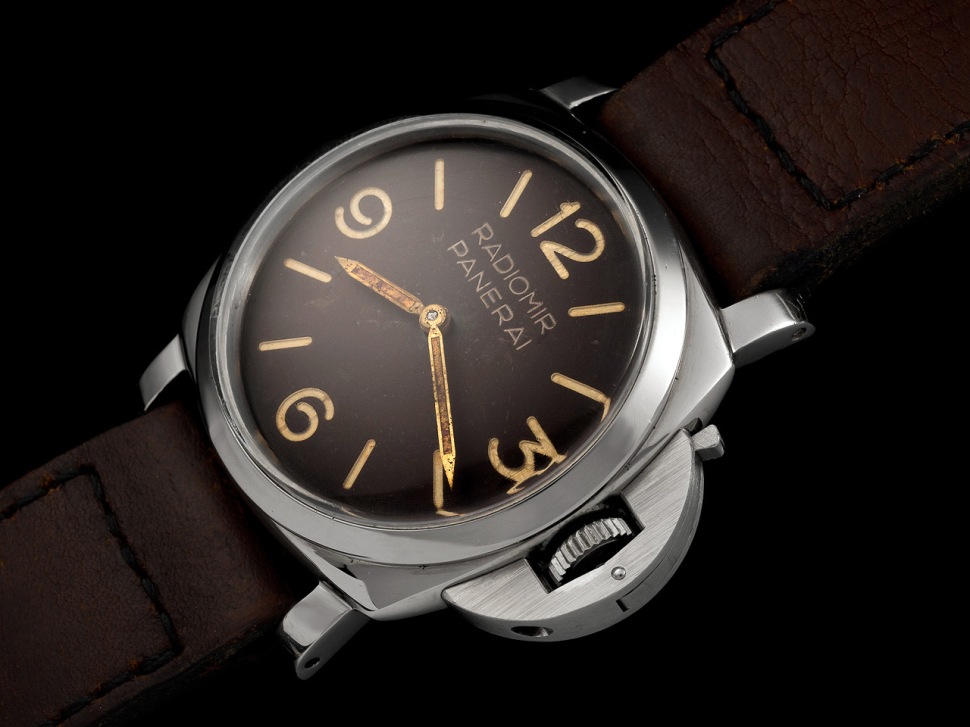
.
As with all other “Panerai” references, Rolex probably delivered complete watches with simple white “interim” dials, which were later replaced by G. Panerai e Figlio.
The first examples of Ref. 6152 1 were delivered to the Italian Navy with 3rd generation sandwich dials made with RADIOMIR luminous paste. RADIOMIR dials remained in production until around 1960. Over their production span, the numerals and markers became thinner.
.
A “Dimmed” Prototype Dial
Interviews with former Italian aussault swimmers reveal that the luminosity of these dials was so strong they had to cover their watches with cloths to avoid being spotted by patrolling sentinels on the surface. To deal with this issue, Panerai developed several sandwich prototype dials with a reduced amount of luminous paste. The dial had thin “Batons” instead of arab numerals at the four cardinal points and smal dots for the rest of the hour indices.
This type of dial was initially made with Radiomir and later also with Luminor.

.
GPF 2/56
The GPF 2/56 was the first watch designed, developed and produced by G. Panerai e Figlio. Every part, except for the Angelus Cal. 240, was made inhouse in Florence.

.
In 1955, rising tensions between Egypt and Great Britain, a colonial power in decline, were at an explosive level. Facing a possible attack by Great Britain and also to gain influence in the middle east, Egypt decided to purchase a large amount of arms from the Soviet Union. The situation escalated rapidly to what is known today as the “Suez Canal Crisis”.
Italy had close ties to Egypt, in fact Italy had also helped Egypt to establish an assault swimmer unit since 1948. In 1955, after having received the approval of the Italian Navy High Command, the Egyptian Navy approached G. Panerai e Figlio in order to acquire instruments and watches for frogmen. This was a great business opportunity for G. Panerai e Figlio. Since Panerai had an exclusivity agreement with Rolex, which allowed the supply of Rolex-made watches only to the Italian Navy, it was a logical step for Panerai to create its first “own” watch, the GPF 2/56.
Dials for the GPF 2/56 were made in the same way as previous “sandwich” dials but the diameter was considerably larger. Since Angelus Cal. 240 movements had not been developed for the use in wrist watches, there is no specific way to fix the dial to the movement. Panerai made these dials nevertheless with dial feet, but the sole purpose of the feet was to keep the dial in the right postion.
.
With the GPF 2/56, Panerai introduced the small seconds hand at 9, which would later also appear on modified 3646 and 6152/1. To visually ballance the dial, Panerai added the “8 Giorni Brevettato” (8 Days Patented) logo at 3 to visually balance the dial. BREVETTATO (Patented) probably refers to the crown-protecting device, a feature that was introduced with the GPF 2/56. The patent request for this device was made on November 30, 1955. The watch itself was never patented.
The GPF 2/56 remained in production until the early 1960s. There is also a version with LUMINOR dial. It is assumed that around 50 pieces were made.
.
Dealing with radioactivity
Aware of the health risks associated with the use of Radium, Panerai began to replace the dangerous radioactive RADIOMIR around 1965 with Luminor, a tritium-based luminous paste. LUMINOR as a trademark had already been registered in 1949.
.
LUMINOR (1965)
All watches delivered from 1965 onwards were equipped exclusively with modern LUMINOR dials. Most watches of Ref. 6152/1 that had been delivered between 1956 and 1960 received new Luminor dials as well. The dial replacement took place at the site of the Italian Navy. The old Radiomir dials were disposed of. The story goes that old RADIOMIR dials along with complete 3646 watches and instruments were put in a wooden ammunition crate that was sealed with cement and sunk in the sea near La Spezia.

.
Watches for the various Italian Navy units, such as COMSUBIN (Comando Raggruppamento Subacquei e Incursori), were equipped with “MARINA MILITARE” dials.
.
“Panerai” watches were also supplied to “domestic” forces such as the police (Carabinieri) or the fire fighters. Watches for these units had dials with “LUMINOR PANERAI” engravings.
.
Although the basic construction remained the same as in 1950s Radiomir Panerai dials, the design nevertheless evolded until the introduction of the LUMINOR lume. Luminor was probably already less luminous than Radiomir and in order to dim the dials further, Panerai made the numerals and markers slightly thinner.
.
The following picture shows that the lume on modern LUMINOR dials is located directly underneath the aluminium disc, just like on 1950s Radiomir dials.

.
Modified 3646 & 6152 1 with Angelus 240 (1960s)
The Cortebert Cal. 618 has its origins in 1932. A hand-wound movement with a power reserve of only 38 hours was completely outdated in 1960. The Rolex Submariner, for instance, was equipped with an automatic movement from the start in 1953.
The introduction of the Angelus Cal. 240 with 8-days power reserve was an attempt to offer a contemporary version of the watches with a long power reserve that could compete with state of the art automatic watches.
The watch below was probably one of the first Rolex-made “Panerai” watches to be “modified” with an Angelus 240 movement and the corresponding Angelus dial with sub seconds at 9.

.
The first examples (Matr. No. 1 -30) to receive Angelus 240 calibers were 3646 Type F/G watches that had been lying around for more than a decade.
The modification also includes solid lugs which were welded to the case instead of the outdated wire lugs and a fine sandblasting of the middle case to make it matte.
The second batch (Matr. No. 31 – 60 consisted of 6152/1 watches without the iconic crown-protecting device. This series of watches were probably made for demonstration purposes and also as presents or to be awarded to officers of the Italian Navy. To highlight the new 8-days movement, Panerai introduced a display caseback with the iconic engravings “OFFICINE PANERAI – BREVETTATO” (Officine Panerai – Patented). These watches were not meant to be used as combat swimmer equipment, due to the display caseback.

.
Panerai strictly installed 4-liner dials with either “MARINA MILITARE OFFICINE PANERAI” or “MARINA MILITARE LUMINOR PANERAI”.
After this first run, Panerai began to systematically modify Ref. 6152/1 with Angelus 240 movements for the hardcore underwater use, always in combination with the crown-protecting device and a closed caseback. The Italian Navy ordered the watches according to their needs and by the end of the 1960s, a final order of 21 6152/1 with Angelus 8-days movements was made.
6152/1 with Angelus 240 caliber featured for the first time a small seconds hand at 9. In consequence, the arab numerals and markers moved slightly to the edge of the dial.
Panerai found a method to fix the dials properly to the movements. The following picture shows that one of the dial feet was hollow and threaded. The problem with this method was that the whole barrel plate had to be removed in order to reach the screw.
.
Angelus Cal. 240 dials were made with various word combinations:
- OFFICINE PANERAI
- MARINA MILITARE OFFICINE PANERAI
- MARINA MILITARE LUMINOR PANERAI
- MARINA MILITARE
- LUMINOR PANERAI
This type of dials were the last to be produced by G. Panerai e Figlio.
Giuseppe Panerai was the ingenious “mastermind” behind G. Panerai e Figlio. Most of the company’s creations were the result of his inventive genius. After his death in February 1972, the company would never be the same again.
he following timeline shows the evolution of Panerai watches from the early days until 1998.
This timeline is available as a high quality print in two sizes:
- 120 x 68 cm (47 x 26 inch): EUR 85.00 (plus shipping)
- 150 x 85 cm (59 x 33 inch): EUR 120.00 (plus shipping)
Printed with HD Inkjet on heavy synthetic paper, laminated.
Limited edition: 50 pieces, numbered and signed by Maria Teresa Panerai, the widow of Giuseppe Panerai, at the historical site of the Villino Panerai (Panerai Villa) in Florence: Sold out
More information: The history of Panerai watches at a glance
Thank you for your interest.

